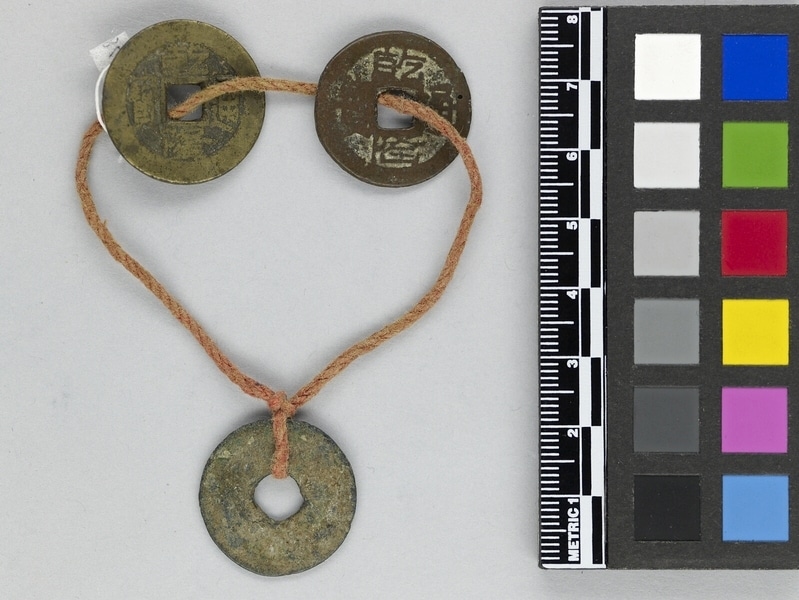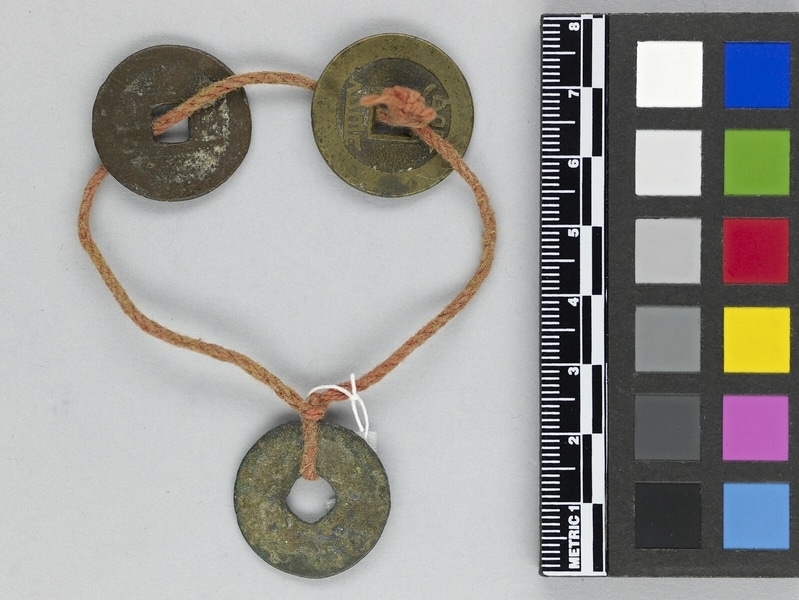Coin Item Number: Edz1084 from the MOA: University of British Columbia


Description
Orange string loop with three coins with square holes through their centres attached to it--one coin is tied to the string while the other two are strung through the centre.
History Of Use
Coins were used for purchases and were sometimes tied together to save them. They were also used to give supernatural protection to children, perhaps because they represented the power of the emperor and were embossed with calligraphy, which also had power. Coins that were strung or fastened on a red cord could be tied around a child’s ankle, wrist, or neck for protection, especially if he or she was prone to illness. This might have been recommended by a woman with special spiritual powers who was consulted by the child’s mother out of concern. Jade pieces were and are also worn for this purpose. Other ways of protecting children included calling them derogatory names such as “little dog”, or having them call their parents by kinship terms that suggested that they had not been born to them and therefore were less valued. Based on the principle of “spirit sadism”, children who appeared to be less valued were believed less likely to be killed by evil spirits. In the first half of the twentieth century approximately half of the children born in the New Territories did not survive to adulthood. After the mid-twentieth century the New Territories of Hong Kong began to undergo fundamental changes. With these changes came the introduction of western medicine. As most childhood illnesses could then be successfully treated, people were less likely to turn to traditional spirit mediums for advice on protecting their children, although children continue to wear jade pieces even now. The people who had been settled in the New Territories before 1898, when the British colonizers claimed the area, began to give up rice agriculture and coastal fishing, turning instead to wage labour and increased employment overseas. By the end of the century, educational opportunities leading to the possibility of white-collar work also increased, together with western influences. These changes meant that objects and clothing once useful and appropriate were no longer needed and generally were discarded. Some were saved by their owners, who sometimes were willing to donate them to museums, sharing, also, their knowledge of how they were made and used.
Cultural Context
economic; ritual
Iconographic Meaning
The colour red is both auspicious and protective. Chinese dynastic coins also have protective power, probably through the presence of calligraphy that represents the power of the emperor.
Narrative
This object is one of a number of old and no longer used objects collected from relatives of Mrs. Yau Chan, Shek –ying. She understood the purpose of the museum and of developing its collections, and encouraged her relatives to donate them. She also documented the objects for MOA based on her remarkable memory and understanding.
Chik Wai Koon Village was about to be destroyed to make way for the development of Shatin New Town, and its residents moved to new housing. Hakka people are one of the two original land-dwelling groups that settled the area that became the New Territories of Hong Kong. Their spoken language, and some customs, differed from those of the other original group, the Cantonese or Punti. The Cantonese arrived first and settled on the best rice-growing lands, while the Hakka began to arrive after the late 17th century and settled the more hilly lands.
Item History
- Made in Chik Wai Koon, Hong Kong, China
- Collected by Elizabeth L. Johnson during 1979
- Owned by Kiu Tsang
- Owned by Elizabeth L. Johnson before March 17, 1980
- Received from Elizabeth L. Johnson (Seller) and Museum of Anthropology Shop Volunteers (Funding source) on March 17, 1980
What
- Name
- Coin
- Identification Number
- Edz1084
- Type of Item
- coin
- Material
- brass metal, cotton fibre and dye
- Manufacturing Technique
- cast, spun, dyed and tied
- Overall
- height 0.5 cm, diameter 6.0 cm
Who
- Culture
- Chinese: Hakka
- Field Collector
- Elizabeth L. Johnson
- Previous Owner
- Kiu Tsang and Elizabeth L. Johnson
- Received from
- Elizabeth L. Johnson (Seller) and Museum of Anthropology Shop Volunteers (Funding source)
Where
- Holding Institution
- MOA: University of British Columbia
- Made in
- Chik Wai Koon, Hong Kong, China
When
- Collection Date
- during 1979
- Ownership Date
- before March 17, 1980
- Acquisition Date
- on March 17, 1980
Other
- Item Classes
- metalwork
- Condition
- good
- Accession Number
- 0610/0054